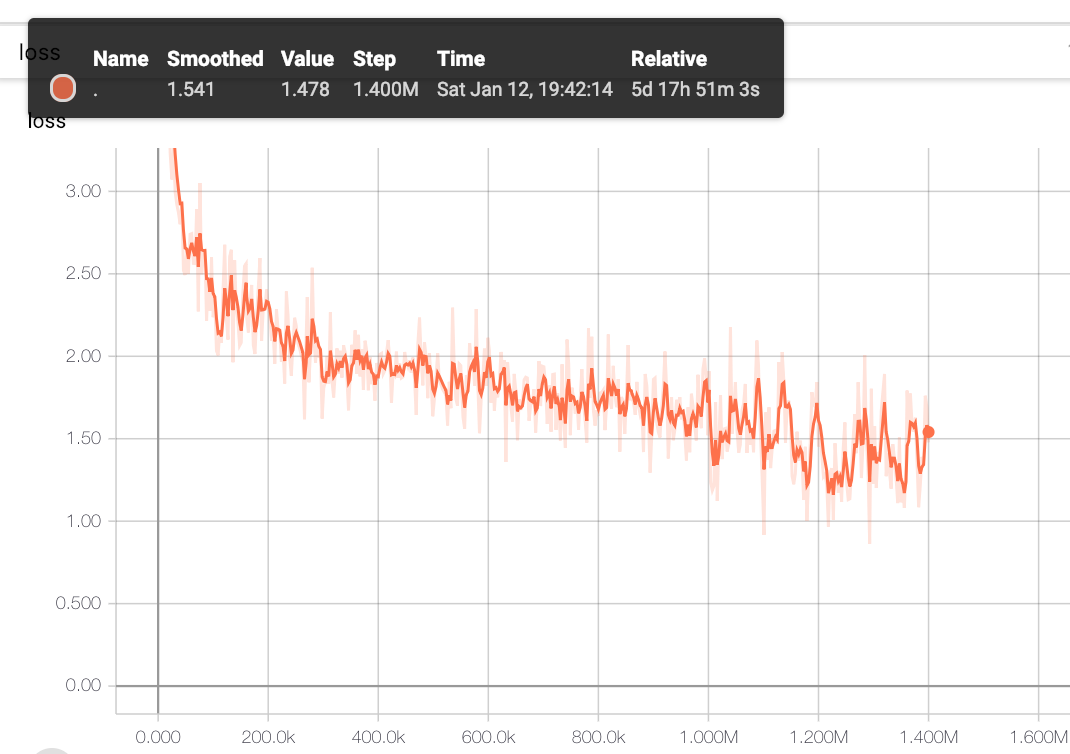This is a repository of Japanese BERT model with SentencePiece tokenizer.
We provide pretrained BERT model and trained SentencePiece model for Japanese text.
Training data is the Japanese wikipedia corpus from Wikimedia Downloads.
Please download all objects in the following google drive to model/ directory.
Loss function during training is as below (after 1M steps the loss function massively changes because max_seq_length is changed from 128 to 512.):

***** Eval results *****
global_step = 1400000
loss = 1.3773012
masked_lm_accuracy = 0.6810424
masked_lm_loss = 1.4216621
next_sentence_accuracy = 0.985
next_sentence_loss = 0.059553143
We also provide a simple Japanese text classification problem with livedoor ニュースコーパス.
Try the following notebook to check the usability of finetuning.
You can run the notebook on CPU (too slow) or GPU/TPU environments.
The results are the following:
- BERT with SentencePiece
precision recall f1-score support dokujo-tsushin 0.98 0.94 0.96 178 it-life-hack 0.96 0.97 0.96 172 kaden-channel 0.99 0.98 0.99 176 livedoor-homme 0.98 0.88 0.93 95 movie-enter 0.96 0.99 0.98 158 peachy 0.94 0.98 0.96 174 smax 0.98 0.99 0.99 167 sports-watch 0.98 1.00 0.99 190 topic-news 0.99 0.98 0.98 163 micro avg 0.97 0.97 0.97 1473 macro avg 0.97 0.97 0.97 1473 weighted avg 0.97 0.97 0.97 1473 - sklearn GradientBoostingClassifier with MeCab
precision recall f1-score support dokujo-tsushin 0.89 0.86 0.88 178 it-life-hack 0.91 0.90 0.91 172 kaden-channel 0.90 0.94 0.92 176 livedoor-homme 0.79 0.74 0.76 95 movie-enter 0.93 0.96 0.95 158 peachy 0.87 0.92 0.89 174 smax 0.99 1.00 1.00 167 sports-watch 0.93 0.98 0.96 190 topic-news 0.96 0.86 0.91 163 micro avg 0.92 0.92 0.92 1473 macro avg 0.91 0.91 0.91 1473 weighted avg 0.92 0.92 0.91 1473
All scripts for pretraining from scratch are provided. Follow the instructions below.
Build a docker image with Dockerfile and create a docker container.
Data downloading and preprocessing. It takes about one hour on GCP n1-standard-8 (8CPUs, 30GB memories) instance.
python3 src/data-download-and-extract.py
bash src/file-preprocessing.sh
Train a SentencePiece model using the preprocessed data. It takes about two hours on the instance.
python3 src/train-sentencepiece.py
Create .tfrecord files for pretraining.
For longer sentence data, replace the value of max_seq_length with 512.
for DIR in $( find /work/data/wiki/ -mindepth 1 -type d ); do
python3 src/create_pretraining_data.py \
--input_file=${DIR}/all.txt \
--output_file=${DIR}/all-maxseq128.tfrecord \
--model_file=./model/wiki-ja.model \
--vocab_file=./model/wiki-ja.vocab \
--do_lower_case=True \
--max_seq_length=128 \
--max_predictions_per_seq=20 \
--masked_lm_prob=0.15 \
--random_seed=12345 \
--dupe_factor=5
done
You need GPU/TPU environment to pretrain a BERT model.
The following notebook provides the link to Colab notebook where you can run the scripts with TPUs.